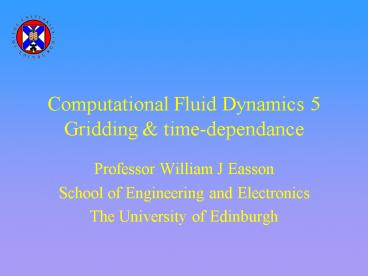Computational Fluid Dynamics 5 Gridding - PowerPoint PPT Presentation
1 / 18
Title:
Computational Fluid Dynamics 5 Gridding
Description:
Create simple geometries in Star-Design ... Un-structured grids (eg tet) Advantages: Can be fitted to unusual shapes. One-click' creation ... – PowerPoint PPT presentation
Number of Views:59
Avg rating:3.0/5.0
Title: Computational Fluid Dynamics 5 Gridding
1
Computational Fluid Dynamics 5Gridding
time-dependance
- Professor William J Easson
- School of Engineering and Electronics
- The University of Edinburgh
2
Things you can do
- Create simple geometries in Star-Design
- Produce meshes of different densities and of
varying density (by changing the parameters
before meshing) - Solve for laminar flow in a 2D channel
- Present the output in a variety of formats
- Solve for 2D laminar jets
- Solve for 2D flows with wall attachment
- Solve to 1st 2nd order simulations (check this)
- Test the appropriateness of your mesh density
(check) - Test the appropriateness of the extent of your
domain
3
Things you can do
- Simulate steady, turbulent flow
- Simulate flow past objects in a domain
- Calculate the drag coefficient using the sum of
forces on an object in a flow - Determine whether flow solution is dominated by
hyperbolic, parabolic or elliptic behaviour - Utilise time-dependant equations to enhance
convergence for elliptically-dominated solutions
4
Moody Diagram (Chart)
5
Gridding
- Anderson and Versteek Malalasekera both weak on
gridding
6
Structured grids (eg hex)
- Advantages
- Equations relatively simple
- Cell shape is easily controlled
- Numerical errors are smaller
- Can be fitted to flow direction
- Can be fitted to gradients in flow
- Optimises memory use
- Disadvantages
- Fitting to complex geometries requires a lot of
time and skill
7
Structured grid
8
Structured grid (2)
9
Un-structured grids (eg tet)
- Advantages
- Can be fitted to unusual shapes
- One-click creation
- Disadvantages
- Generally larger errors
- Limited control over cell shape skewness
10
Unstructured grid
11
Exercise 1
- Simulate laminar flow through a straight pipe 8mm
dia and 50mm long. Increase the cell density next
to the wall - Using a structured grid by creating a prism layer
- Using a triangular grid with a growth function
- Note the number of cells created in each case and
the relative convergence time
12
Time-dependant flows
- Anderson Ch4
- Versteeg Malalasekera Ch8
13
Time dependant modelling
- Many flows are inherently time-dependant and
therefore require to be modelled as such - Some steady-state flow solutions are not
well-behaved and therefore require to be modelled
by time-dependent equations to achieve convergence
14
Classification of NS
- General NS equations are of mixed class
15
Explicit techniques
- Solution at time-step t?t is obtained by
marching forward from time-step t and obtaining
gradients for estimating new values from those at
previous time-step - Easy to program and quick to solve, but can be
unstable if ?t too large (conditionally stable) - ?tmax is proportional to (?x)2, so quickly
becomes very small and limits usefulness of
solution
16
Implicit techniques
- Solution at time-step t?t is obtained by
marching forward from time-step t and obtaining
gradients for estimating new values from those at
previous and current time-step - Crank-Nicolson is an early example
- Requires solution of large number of simultaneous
equations (also extra loops inside iteration
process) - Conditionally, or even unconditionally, stable
- Large ?t results in errors not instability
- May be quicker to converge than explicit due to
improved stability
17
Time-dependant example
- Vortex shedding past a cylinder
- 2D example
- Use laminar flow, 16mm cylinder at 7.5mm/s
(Re120 ) - Create unstructured grid using sizing function
- Use an unsteady solver
- Calculate the shedding frequency and check that
it matches the strouhal number
18
(No Transcript)































